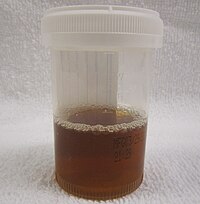
Photo from wikipedia
Abstract Objective Rhabdomyolysis is associated with methamphetamine, amphetamine, and methylenedioxymethamphetamine (MA) use. The aim of this study was to determine the frequency, severity, and risk factors of rhabdomyolysis associated with… Click to show full abstract
Abstract Objective Rhabdomyolysis is associated with methamphetamine, amphetamine, and methylenedioxymethamphetamine (MA) use. The aim of this study was to determine the frequency, severity, and risk factors of rhabdomyolysis associated with MA use. Methods: We reviewed patients with an MA-positive toxicology screen with and without diagnosed rhabdomyolysis based on initial creatine kinase (CK) concentration over a period of 6 years. Demographics, vital signs, disposition, diagnoses, and laboratory results were recorded. Results: There were 7,319 patients with an MA-positive toxicology screen, of whom 957 (13%) were screened for rhabdomyolysis and included in the study. The majority were male, White, and middle-aged and smoked tobacco. Psychiatric (34%), neurological (15%), and trauma (13%) were the most common discharge diagnostic groups. The majority (55%) were admitted, and 8% were discharged to an inpatient psychiatric facility. Concomitant substance use included ethanol (10%) and cocaine (8%), and 190 (20%) had rhabdomyolysis with median (interquartile range) CK of 2,610 (1,530–6,212) U/L and range 1,020 to 98,172 U/L. There was significant difference in renal function between the rhabdomyolysis and non-rhabdomyolysis patients. Other differences included gender and troponin I concentration. A higher proportion of patients screening positive for both MA and cocaine use experienced rhabdomyolysis. Multiple logistic regression analysis revealed elevated troponin I, blood urea nitrogen, and/or creatinine concentration and male gender to be significant factors associated with rhabdomyolysis. Conclusions: The frequency of rhabdomyolysis in patients screening positive for MA was 20%. Factors associated with rhabdomyolysis in MA-positive patients included elevated troponin, blood urea nitrogen, creatinine concentration, and male gender. Clinicians caring for patients who screen positive for MA should also consider concomitant rhabdomyolysis, especially if renal/cardiac laboratory tests are abnormal and even if there is no history of injury, agitation, or physical restraint.
Journal Title: Journal of Dual Diagnosis
Year Published: 2020
Link to full text (if available)
Share on Social Media: Sign Up to like & get
recommendations!